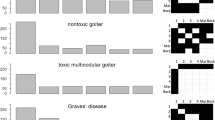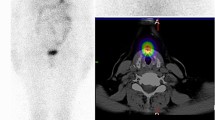Abstract
Purpose
The residence time of 131I in the blood is likely to be a measure of the amount of 131I that is available for uptake by thyroid remnant tissue and thus the radiation absorbed dose to the target tissue in 131I ablation of patients with differentiated thyroid cancer (DTC). This hypothesis was tested in an investigation on the dependence of the success rate of radioiodine remnant ablation on the radiation absorbed dose to the blood (BD) as a surrogate for the amount of 131I available for iodine-avid tissue uptake.
Methods
This retrospective study included 449 DTC patients who received post-operative 131I ablation in our centre in the period from 1993 to 2007 and who returned to us for diagnostic whole-body scintigraphy. The BD was calculated based on external dose rate measurements using gamma probes positioned in the ceiling. Success of ablation was defined as a negative diagnostic 131I whole-body scan and undetectable thyroglobulin levels at 6 months follow-up.
Results
Ablation was successful in 56.6% of the patients. The rate of successful ablation correlated significantly with BD but not with the administered activity. Patients with blood doses exceeding 350 mGy (n = 144) had a significantly higher probability for successful ablation (63.9%) than the others (n = 305, ablation rate 53.1%, p = 0.03). In contrast, no significant dependence of the ablation rate on the administered activity was observed.
Conclusion
The BD is a more powerful predictor of ablation success than the administered activity.



Similar content being viewed by others
References
Verburg FA, de Keizer B, Lips CJ, Zelissen PM, de Klerk JM. Prognostic significance of successful ablation with radioiodine of differentiated thyroid cancer patients. Eur J Endocrinol 2005;152:33–7.
Verburg FA, Stokkel MP, Düren C, Verkooijen RB, Mäder U, van Isselt JW, et al. No survival difference after successful (131)I ablation between patients with initially low-risk and high-risk differentiated thyroid cancer. Eur J Nucl Med Mol Imaging 2010;37:276–83. doi:10.1007/s00259-009-1315-6.
Pacini F, Schlumberger M, Dralle H, Elisei R, Smit JW, Wiersinga W. European consensus for the management of patients with differentiated thyroid carcinoma of the follicular epithelium. Eur J Endocrinol 2006;154:787–803.
American Thyroid Association (ATA) Guidelines Taskforce on Thyroid Nodules and Differentiated Thyroid Cancer, Cooper DS, Doherty GM, Haugen BR, Kloos RT, Lee SL, et al. Revised American Thyroid Association management guidelines for patients with thyroid nodules and differentiated thyroid cancer. Thyroid 2009;19:1167–214.
Luster M, Clarke SE, Dietlein M, Lassmann M, Lind P, Oyen WJ, et al. Guidelines for radioiodine therapy of differentiated thyroid cancer. Eur J Nucl Med Mol Imaging 2008;35:1941–59.
Gharib H, Papini E, Valcavi R, Baskin HJ, Crescenzi A, Dottorini ME, et al. American Association of Clinical Endocrinologists and Associazione Medici Endocrinologi medical guidelines for clinical practice for the diagnosis and management of thyroid nodules. Endocr Pract 2006;12:63–102.
Dietlein M, Dressler J, Eschner W, Grünwald F, Lassmann M, Leisner B, et al. Procedure guidelines for radioiodine therapy of differentiated thyroid cancer (version 3). Nuklearmedizin 2007;46:213–9.
Sawka AM, Brierley JD, Tsang RW, Thabane L, Rotstein L, Gafni A, et al. An updated systematic review and commentary examining the effectiveness of radioactive iodine remnant ablation in well-differentiated thyroid cancer. Endocrinol Metab Clin North Am 2008;37:457–80.
Bal C, Padhy AK, Jana S, Pant GS, Basu AK. Prospective randomized clinical trial to evaluate the optimal dose of 131 I for remnant ablation in patients with differentiated thyroid carcinoma. Cancer 1996;77:2574–80.
Bal CS, Kumar A, Pant GS. Radioiodine dose for remnant ablation in differentiated thyroid carcinoma: a randomized clinical trial in 509 patients. J Clin Endocrinol Metab 2004;89:1666–73.
Hackshaw A, Harmer C, Mallick U, Haq M, Franklyn JA. 131I activity for remnant ablation in patients with differentiated thyroid cancer: a systematic review. J Clin Endocrinol Metab 2007;92:28–38.
Hänscheid H, Lassmann M, Luster M, Thomas SR, Pacini F, Ceccarelli C, et al. Iodine biokinetics and dosimetry in radioiodine therapy of thyroid cancer: procedures and results of a prospective international controlled study of ablation after rhTSH or hormone withdrawal. J Nucl Med 2006;47:648–54.
Lassmann M, Reiners C, Luster M. Dosimetry and thyroid cancer: the individual dosage of radioiodine. Endocr Relat Cancer 2010;17:R161–72.
Sobin LH, Wittekind C. TNM classification of malignant tumours. Berlin: Springer; 1997.
Sobin LH, Wittekind C, Wittekind C. TNM classification of malignant tumours. New York: Wiley-Liss; 2002.
Lassmann M, Luster M, Hänscheid H, Reiners C. Impact of 131I diagnostic activities on the biokinetics of thyroid remnants. J Nucl Med 2004;45:619–25.
Medvedec M. Thyroid stunning in vivo and in vitro. Nucl Med Commun 2005;26:731–5.
Verburg FA, Verkooijen R, Stokkel M, van Isselt J. The success of 131I ablation in thyroid cancer patients is significantly reduced after a diagnostic activity of 40 MBq 131I. Nuklearmedizin 2009;48:138–42.
Hänscheid H, Lassmann M, Luster M, Kloos R, Reiners C. Blood dosimetry from a single measurement of the whole body radioiodine retention in patients with differentiated thyroid carcinoma. Endocr Relat Cancer 2009;16:1283–9.
Schlumberger M, Pacini F. Thyroid tumors. 3rd ed. Paris: Editions Nucleon; 2006.
Spencer CA, Takeuchi M, Kazarosyan M, Wang CC, Guttler RB, Singer PA, et al. Serum thyroglobulin autoantibodies: prevalence, influence on serum thyroglobulin measurement, and prognostic significance in patients with differentiated thyroid carcinoma. J Clin Endocrinol Metab 1998;83:1121–7.
Mäenpää HO, Heikkonen J, Vaalavirta L, Tenhunen M, Joensuu H. Low vs. high radioiodine activity to ablate the thyroid after thyroidectomy for cancer: a randomized study. PLoS One 2008;3:e1885. doi:10.1371/journal.pone.0001885.
Pilli T, Brianzoni E, Capocetti F, Castagna MG, Fattori S, Poggiu A, et al. A comparison of 1850 (50 mCi) and 3700 (100 mCi) 131-iodine administered doses for recombinant thyrotropin-stimulated postoperative thyroid remnant ablation in differentiated thyroid cancer. J Clin Endocrinol Metab 2007;92:3542–6.
Logue JP, Tsang RW, Brierley JD, Simpson WJ. Radioiodine ablation of residual tissue in thyroid cancer: relationship between administered activity, neck uptake and outcome. Br J Radiol 1994;67:1127–31.
Flux GD, Haq M, Chittenden SJ, Buckley S, Hindorf C, Newbold K, et al. A dose-effect correlation for radioiodine ablation in differentiated thyroid cancer. Eur J Nucl Med Mol Imaging 2010;37:270–5. doi:10.1007/s00259-009-1261-3.
Luster M, Sherman SI, Skarulis MC, Reynolds JR, Lassmann M, Hänscheid H, et al. Comparison of radioiodine biokinetics following the administration of recombinant human thyroid stimulating hormone and after thyroid hormone withdrawal in thyroid carcinoma. Eur J Nucl Med Mol Imaging 2003;30:1371–7.
Chiesa C, Castellani MR, Vellani C, Orunesu E, Negri A, Azzeroni R, et al. Individualized dosimetry in the management of metastatic differentiated thyroid cancer. Q J Nucl Med Mol Imaging 2009;53:546–61.
Pacini F, Ladenson PW, Schlumberger M, Driedger A, Luster M, Kloos RT, et al. Radioiodine ablation of thyroid remnants after preparation with recombinant human thyrotropin in differentiated thyroid carcinoma: results of an international, randomized, controlled study. J Clin Endocrinol Metab 2006;91:926–32.
Verkooijen RB, Verburg FA, van Isselt JW, Lips CJ, Smit JW, Stokkel MP. The success rate of I-131 ablation in differentiated thyroid cancer: comparison of uptake-related and fixed-dose strategies. Eur J Endocrinol 2008;159:301–7.
Barbaro D, Boni G, Meucci G, Simi U, Lapi P, Orsini P, et al. Radioiodine treatment with 30 mCi after recombinant human thyrotropin stimulation in thyroid cancer: effectiveness for postsurgical remnants ablation and possible role of iodine content in L-thyroxine in the outcome of ablation. J Clin Endocrinol Metab 2003;88:4110–5.
Barbaro D, Boni G, Meucci G, Simi U, Lapi P, Orsini P, et al. Recombinant human thyroid-stimulating hormone is effective for radioiodine ablation of post-surgical thyroid remnants. Nucl Med Commun 2006;27:627–32.
Chianelli M, Todino V, Graziano FM, Panunzi C, Pace D, Guglielmi R, et al. Low-activity (2.0 GBq; 54 mCi) radioiodine post-surgical remnant ablation in thyroid cancer: comparison between hormone withdrawal and use of rhTSH in low-risk patients. Eur J Endocrinol 2009;160:431–6.
Robbins RJ, Tuttle RM, Sonenberg M, Shaha A, Sharaf R, Robbins H, et al. Radioiodine ablation of thyroid remnants after preparation with recombinant human thyrotropin. Thyroid 2001;11:865–9.
de Klerk JM, de Keizer B, Zelissen PM, Lips CM, Koppeschaar HP. Fixed dosage of 131I for remnant ablation in patients with differentiated thyroid carcinoma without pre-ablative diagnostic 131I scintigraphy. Nucl Med Commun 2000;21:529–32.
Barbaro D, Verburg FA, Luster M, Reiners C, Rubello D. ALARA in rhTSH-stimulated post-surgical thyroid remnant ablation: what is the lowest reasonably achievable activity? Eur J Nucl Med Mol Imaging 2010;37:1251–4. doi:10.1007/s00259-010-1402-8.
Elisei R, Schlumberger M, Driedger A, Reiners C, Kloos RT, Sherman SI, et al. Follow-up of low-risk differentiated thyroid cancer patients who underwent radioiodine ablation of postsurgical thyroid remnants after either recombinant human thyrotropin or thyroid hormone withdrawal. J Clin Endocrinol Metab 2009;94:4171–9.
Remy H, Borget I, Leboulleux S, Guilabert N, Lavielle F, Garsi J, et al. 131I effective half-life and dosimetry in thyroid cancer patients. J Nucl Med 2008;49:1445–50.
Conflicts of interest
None.
Author information
Authors and Affiliations
Corresponding author
Electronic supplementary material
Below is the link to the electronic supplementary material.
ESM 1
(PDF 37 kb)
Rights and permissions
About this article
Cite this article
Verburg, F.A., Lassmann, M., Mäder, U. et al. The absorbed dose to the blood is a better predictor of ablation success than the administered 131I activity in thyroid cancer patients. Eur J Nucl Med Mol Imaging 38, 673–680 (2011). https://doi.org/10.1007/s00259-010-1689-5
Received:
Accepted:
Published:
Issue Date:
DOI: https://doi.org/10.1007/s00259-010-1689-5




